Seasons by the Sea: Plotting the Perfect Picnic

Jesus, Mary, and Joseph, it’s been hot out here! I’ll bet all you want to do is escape to the beach and spend the entire day there, dipping in and out of the water, picnicking, and putting off the return home for as long as possible.
The key to a successful day (and evening) at the beach is what you bring. You can keep it as simple as you like with beach towels, sunblock, and some trashy magazines, or go for more comfort with umbrellas, chairs, and a big fat cooler of food and drink. The fact of the matter is, the more you bring, the more comfortable and successful your time will be.
Some of the more essential items, in my opinion, are a small collapsible table and thin bedspreads or tablecloths. The table will keep your food out of the sand. Trust me, no matter how well trained your children or guests or pooch are, somehow sand will get kicked or blown onto your food. And while beach towels may be big enough for you to spread yourself out on, they are not big enough to lay a feast on.
When it comes to food, again, it can be as simple or elaborate as you wish. Some Villa Combos from Villa Italian Specialties in East Hampton are one of my favorites, along with picnic chicken from Round Swamp Farm. But the easiest and most economical trick is to cook extra food at home and use your leftovers in creative ways the next day. Cook a few extra steaks on the grill to make sandwiches or Thai beef salad. Roast an extra chicken. Pastas and rice can be reborn as a salad with vegetables and vinaigrette.
Food historians tell us picnics evolved from elaborate traditions of moveable outdoor feasts enjoyed by the wealthy. There were medieval hunting feasts, Renaissance-era country banquets, and Victorian garden parties. In France, when the beautiful city parks were finally opened to the public, picnics became very popular.
An anonymous article from a 1912 New York Times describes how a proper picnic would evolve. “All eatables were provided by the feminine portion of the party. We weren’t hard to please. A few cold fried chickens, some peanut sandwiches, a big paper sack of Saratoga chips, some potato salad in a fruit jar, two or three kinds of jelly, bread and butter, a couple of chocolate cakes, and a coconut cake and a freeze of strawberry ice cream and a few accessories were practically all we expected.” A couple of chocolate cakes?! The young gent who wrote the article also laid out the battle plan for romance. If a chaperone had to come along, they would find one only a few years older than the picnicking party, then bring along a similarly-aged member of the opposite sex to distract the chaperone. Another article from 1904 recommended “be careful to dress for the entertainment, after consulting the barometer and thermometer.” Also “find a spot with reasonable freedom from tormenting insect life.”
Some of the suggestions are just as practical today as they were then. Rather than lug massive quantities of lemonade or iced tea, bring along concentrates to which you can add water later. Some of the menus, however, are downright peculiar. From 1900, a picnic bill of fare was “cold roast chicken, sandwiches of potted rabbit, Bewitched veal, chow-chow, Bombay toast, pickles, and orange marmalade.” Another menu was fish balls, graham bread and butter, prune whip, and lemonade. Also “sardines, accompanied by sardine-scissors are the easiest to manage, and altogether the most satisfactory — but don’t forget their intimate friends, the lemons.”
Some more up-to-date suggestions are just common sense. Use lightweight materials like recyclable plastic instead of glass bottles. Don’t forget a bag for garbage, a bottle opener, and hand wipes. Take a flashlight so you can find all the flotsam and jetsam that has gotten scattered about in the sand. Finger food makes sense, carrot sticks, deviled eggs, fruit such as grapes, plums, peaches, and watermelon already cut up. Brownies or other bar cookies are easy to transport. If you bring cheese, bring one that will melt nicely in the heat of the day, such as brie or camembert. Don’t bring cheddar; it will just turn oily.
Another cool invention for picnics is the collapsible bowl. Tupperware makes them but I found mine at the pet store! Always bring more water than you think you’ll need, hydration is particularly important for a full day of fun in the sun.
My friend Tommy is a genius cook. Instead of vitello tonatto, a classic, cold Italian dish of sliced veal with tuna sauce, he makes turkey tonatto, using thickly sliced fresh turkey breast from the deli. This is a perfect outdoor dish. You simply puree a can of high quality tuna with a bit of olive oil and lemon juice, pour over turkey slices, and top with capers, lemon slices, and parsley. Add some anchovies if you want to go for super fishy tonatto. Another friend recently made a slaw with asparagus, carrots, and mint. All I could think about was how perfect it would be for a beach picnic.
Some people like to bring lobster rolls and potato salad and other, similarly rich mayonnaise-laden foods to the beach. While commercial mayonnaise is, in fact, a very stable and safe food at room temperature, it’s the other stuff we add to it that could make picnicking risky. Why not just make salads with a vinaigrette instead? And be sure to keep everything on ice until you’re ready to eat. Here are some recipes for your happy, healthy, and safe outdoor dining adventures.
Click for recipes
